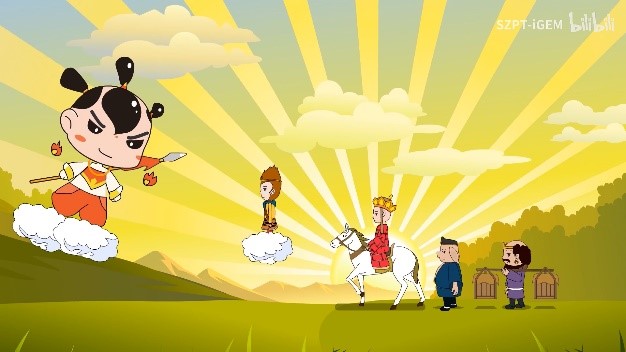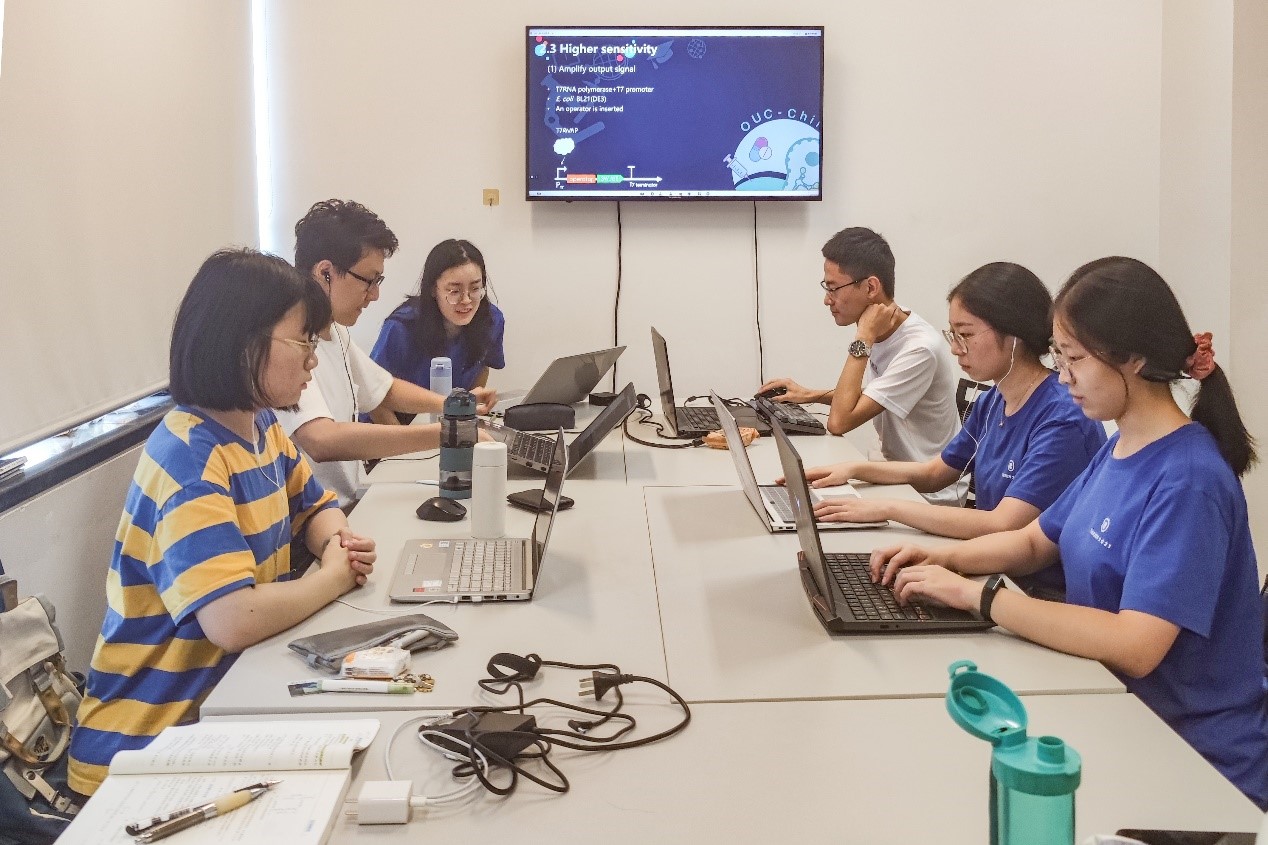
SZPT-CHINA
About
On August 13th, 2021, we had a one-day comminicate with SZPT-CHINA team and talked about how to carry out HP activities. They shared with us their experience of organizing HP events. We helped them dub their picture books through different dialects. Our team, together with SZPT-CHINA, and the other two teams (NWU-CHINA-A & TJUSLS_China), organized a series of online seminars on "Synthetic Biology in Our Daily Life". The lecture started from the life side, and the purpose was to introduce the cutting-edge technology of synthetic biology to people from all walks of life, mainly high school and college students. Click here to view our event!
Why did we decide to this collaboration

When watching the promotion videos of other teams, we were surprised to find that SZPT-CHINA used the same elements of Journey to the West as we did, what a coincident! So we took the initiative to contact them, hoping to cooperate. Through mutual understanding, we found that the HP activities of the SZPT-CHINA team were very rich and varied, so we learned relevant experiences from them, and during the exchange process, we had an idea: September is the time for freshmen to enter the university. In order to stimulate their interest in synthetic biology, let more people learn about synthetic biology and devote themselves to related research, and let non-biology students know more about the frontier knowledge of synthetic biology, our team and SZPT-CHINA, united NWU-CHINA-A and TJUSLS_China and held a series of lectures about "Synthetic Biology in Our Daily Life".

How did we help each other?

Because of the COVID-19, we can only communicate through video conferences and online communication, but this did not stop our enthusiasm for communication with each other, we conducted a wide range of communications on how to host HP events. SZPT-CHINA shared their experience with us, and we also provided some of our own ideas. At the same time, we mobilized students from different regions in our team to use dialects to dub the SZPT-CHINA project promotion picture book, so as to better help them to promote it all over China. We also discussed the "Synthetic Biology in Our Daily Life" series of lectures many times, and contacted the other two teams to improve the schedule and specific content of the event. While planning the entire event, we also strived to ensure that the content of our lectures is closer to life and can attract more people's attention. At the same time, we made sure that the content is both scientific and popular so that most people can understand it.
What did we learn from this collaboration?
We identified two important gains from this fruitful collaboration:
I: We have learned a lot of skills in carrying out HP activities, including how to contact relevant teachers and companies, which provides a good idea for our follow-up HP activities.
II: Through holding lectures, we learned about the broad interest of people of all ages in synthetic biology, which proved that it is necessary for us to promote synthetic biology. Only when more people understand and pay attention to synthetic biology can this science advance and develop better.

DUT_China
Our collaboration with team DUT_China mainly revolves around the two core aspects of our projects-experiments and wiki. While their team helped us solve the web upload problem, we also assisted them connect a plasmid using the CPEC assembly method. Click here to visit their wiki.
Why did we decide to this collaboration
We met and had extensive and friendly exchanges with DUT_China at the Conference of China iGEMer Community (CCiC) conference, and we also established close contact. We found that our team and DUT_China have our own advantages. Our team has certain experience in experimental design, and DUT_China not only does a good job in experimental design, but also does well in modeling and web pages where our team is not good at. Therefore, we have different advantages in the core content of the project. This helps our two teams to better advance our projects.
How did we help each other?


During the communication process, DUT_China raised the problem of plasmid assembly-they could not use the SE seamless assembly method to assemble the three fragments into a plasmid to express PETase and MHETase at the same time. Our team has certain experience in plasmid construction and fragment ligation, so we decided to help each other construct plasmids. In the initial experimental design, we proposed two methods: DNA assembler and CPEC assembly. After analyzing the map of their plasmid, we found that their plasmid was not a shuttle plasmid, so the method of CPEC assembly was chosen to help them construct plasmids. In the end, we successfully helped them clone and sequence the plasmid. And our two teams had a fruitful discussion on the cloning method and results.
We also encountered many problems when submitting wiki, and some members of DUT_China are very good at the front-end development of web pages. For this reason, we had extensive and in-depth exchanges with them, and finally solved the problem of uploading our wiki from the local to the server. And they also helped us solve a series of problems such as style, typesetting, and file calling.

What did we learn from this collaboration?
We identified two important gains from this fruitful collaboration:
I: Communication with other teams can not only broaden our thinking, but also make up for our shortcomings and make our project more mature. In this collaboration, our two teams learn from each other's advantages in different fields and strive to develop more comprehensive projects.
II: The collaboration with DUT_China made us realize the importance of collaboration and communication with teams from different regions and different perspectives. The process of communicating with them has broadened our thinking and improved our relationship with different backgrounds and different personalities. The skills of people working together.
The CRISPR Conference
About
Our team hosted a one-day online conference, the CRISPR Conference, on September 12th, 2021. Eleven iGEM teams actively participated in our interactive sessions and sharing. The purpose of this meeting was to help teams which are also using CRISPR solve their CRISPR problems and to provide some experience for iGEMers who are using CRISPR. Click here to see our event!

Why did we decide to do this collaboration?
CRISPR technology is one of the most efficient gene editing techniques in recent years. Because of the convenience of this technology, many iGEM teams in China also used this technology in their projects this year. But in our conversations with many teams, we found that when people use CRISPR technology, there are some technical challenges that they can't solve on their own. Members of each team have different professional backgrounds, which means that although they can't solve their own team's problems, teams can help each other. So, we held this conference.
How did we help each other?
We first collected the problems of each team, and then drew lots and made adjustments to determine which problems each team should solve. During the CRISPR Conference on September 12th, 2021, discussions will be held. At the same time, we also invited CRISPR experts to share experience and guidance on the CRISPR conference. After the meeting, we sent the CRISPR Application Guide to the teams.
What did we learn from this collaboration?
A) Project: the methods provided by CPU effectively guided our experiment. We constructed flipped plasmids based on their suggestions. At the same time, we also gave technical advice to CPU_China.
B) Friendship: Our cooperation with CPU_China has been further deepened, which not only promoted the development of the project, but also gained a lot of friendship.
C) Synthetic biology collaboration: This field is based on multidisciplinary collaboration and information exchange. Through this collaboration, multiple teams learned from each other in different areas and worked together to develop more comprehensive projects.
D) Communication: When presenting our project to other teams, we got some useful feedback based on audience understanding. At this conference, our level of expression has improved.

Overview
We organised a one-day conference, the CRISPR conference, with 11 iGEM teams participating. The conference, consisting of project presentations, proposals, free discussion and expert sharing, aimed to solve the technical challenges of using CRISPR for iGEMers.

PRE-EVENT
CRISPR/Cas (Clustered Regularly Interspaced Short Palindromic Repeats/CRISPR- Associated Proteins) is an acquired immune defense system widely available in prokaryotes to resist the invasion of foreign genetic material. CRISPR/Cas is the third generation of gene editing techniques following zinc finger nucleases (ZFNs) and transcription activator-like effector nucleases (TALENS). Compared with gene targeting techniques such as ZFN and TALEN, this technology is simple and much more economical. General laboratories can build their own platforms.
When we participated in CCiC, through communication with many teams, we learned that teams using CRISPR technology had problems in CRISPR technology that needed to be solved. So we contacted the team leaders and expressed our plan to host the CRISPR conference. They were very responsive.

EVENT
Our work for the CRISPR conference is outlined below.

On the day of the conference, all teams had effective and pleasant communication. Not only did they solve problems with the CRISPR technology on the project, but they also made friends. We also benefited a lot from the sharing of Dr. Xu. Here is the video of our meeting.
POST-EVENT
After the conference, our team produced a CRISPR Application Guide, which can be downloaded here.
